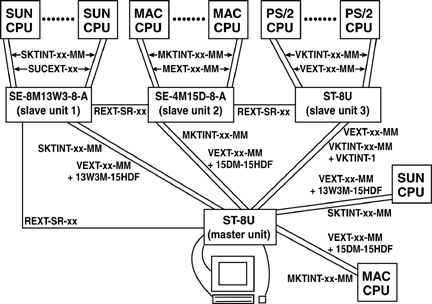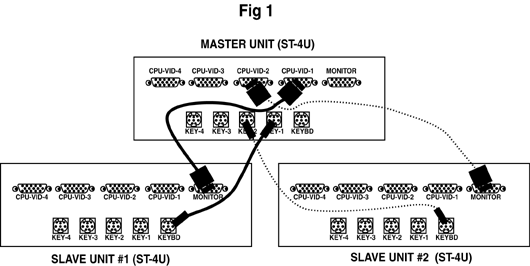Hot-pluggable & Cascade/Daisy Chain
| Questions? | |||||||||||||||||||||||||||||||||||||||||||||||||||||||||||||||||||||||||||||||||||||||||||||
1. Can I connect a computer to a switch that is powered? 2. Do I have to reboot every time I switch to another server? 3. I installed a new CPU Module and now I can't address it. What is wrong? Cascade 4. I am using all the channels on my current NTI KVM switch. Can I control additional servers from the same keyboard, monitor and mouse by cascading? 5. How do I cascade NTI's switches? 6. I have different models of NTI KVM switches. Is there an order in which I should cascade them? 7. How far can the switches be located from each other when cascading? 8. What should the DIP switch settings be when I cascade NTI switches? 9. I have two single-user 12-port PC units; can I cascade them? 10. When I cascade single-user PC units, does it matter where the OSD unit is? | |||||||||||||||||||||||||||||||||||||||||||||||||||||||||||||||||||||||||||||||||||||||||||||
| Answers! | |||||||||||||||||||||||||||||||||||||||||||||||||||||||||||||||||||||||||||||||||||||||||||||
1.Can I connect a computer to a switch that is powered? Yes, Connect a computer that is UNPOWERED, then turn that computer on. 2. Do I have to reboot every time I switch to another server? No, there is constant keyboard and mouse emulation to all attached CPUs. Therefore, the computer constantly thinks there is a keyboard attached and active. 3. I installed a new CPU Module and now I can't address it. What is wrong? Check the jumper blocks per page 8 of the downloadable PDF Manual 025 located at the bottom of the ST-nXm Modular Matrix KVM Switch page.
4. I am using all the channels on my current NTI KVM switch. Can I control additional servers from the same keyboard, monitor and mouse by cascading? Yes, you can cascade NTI's electronic switches to control up to 128 computers as if from one switch. Our Multi-Platform/Multi-User KVM switches can now be cascaded to up to 512 computers. 5. How do I cascade NTI's switches? The UNIVERSAL switch can be expanded to access up to 128 CPU's by cascading multiple units together. Up to 8 SUN, MAC or UNIVERSAL switches can be connected into another switches CPU ports, as illustrated below. The UNIVERSAL switch connected to the monitor & keyboard must be configured as the "MASTER" unit (via dip-switches). Any switches connected to the "MASTER" must be configured as "SLAVE" units. Refer to Tables 2-4 for instructions on proper cascading dip-switch configurations. All UNIVERSAL switches are fully configurable for this expansion method, the only additional hardware required is a set of keyboard, monitor & RMT extension cables for each "SLAVE UNIT". 

When you cascade different models of NTI KVM switches together, they must be ordered in a specific way to work correctly. Contact Customer Service at 800-742-8324. 7. How far can the switches be located from each other when cascading? NTI products allow you to locate the CPUs up to 250 feet from the keyboard, monitor and mouse with crisp and clear 1900x1200 resolution, or up 500 feet at 800x600 VGA resolution, with no degradation of signal. 8. What should the DIP switch settings be when I cascade NTI switches? Answer coming soon. 9. I have two single-user 16-port PC units; can I cascade them? Yes. When cascading the units, you must set the DIP switches to the proper setting. You can use a 4-port, an 8-port, or a 16-port switch as a slave and you can use any size single-user switch (excluding 2-port switches) for the master. For example, you can cascade a 16-port switch off of a 16-port switch if you set the DIP switch setting to 16-port. However, in this example the switch will tell you that you have 27 ports available when really you only have 23. We don't suggest you do this. If you do, it is recommended that you use the front panel push buttons to do your switching. 10. When I cascade single-user PC units, does it matter where the OSD unit is? Although you can cascade in any fashion, only the Master needs to be OSD. It would be more economical to have a regular unit and an OSD unit. If you cascade an OSD unit off a regular unit, you can use the switch(es) in a normal fashion, except you won't be able to use the OSD. | |||||||||||||||||||||||||||||||||||||||||||||||||||||||||||||||||||||||||||||||||||||||||||||